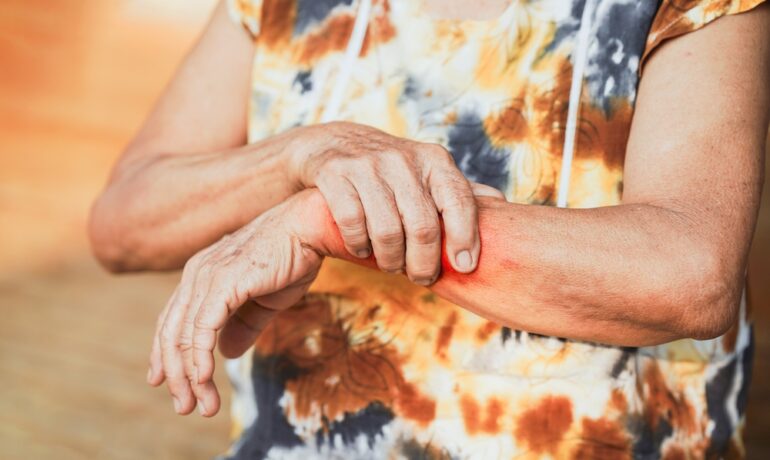As we age, our bodies undergo numerous changes that can often bring unexpected health challenges. One such challenge is psoriasis, a skin condition that causes cells to build up rapidly on the skin’s surface, forming scales and itchy, dry patches.
Although psoriasis can develop at any age, new research suggests that those who develop this condition in their later years have a greater risk of developing psoriatic arthritis as well.1 Let’s discuss the connection between these conditions, symptoms to watch for, and why early diagnosis is crucial for maintaining quality of life.
The Link Between Psoriasis and Psoriatic Arthritis
If you’re dealing with psoriasis, you already know how unpredictable — and uncomfortable — it can be. But for many seniors, psoriasis can lead to something more complicated: psoriatic arthritis (PsA). Around 30% of people with psoriasis will develop PsA, and the risk grows with age.2
The risk of psoriatic arthritis may be even higher for seniors who receive a psoriasis diagnosis later in life. A recent study published in ACR Open Rheumatology found that people diagnosed with psoriasis at an older age are more likely to develop PsA much sooner than those diagnosed at a younger age.1,3
This is why PsA monitoring is essential for older adults diagnosed with psoriasis.
Common Signs of Psoriatic Arthritis in Seniors with Psoriasis
For seniors with psoriasis, recognizing the early signs of PsA is key to managing and potentially mitigating severe joint damage. Here are some common symptoms:
- Joint Pain and Stiffness: This is often the first noticeable symptom of PsA. Seniors might experience stiffness in their joints, especially in the mornings or after periods of rest, that make it challenging to perform daily tasks.
- Swollen Fingers and Toes (Dactylitis): Swelling in the fingers and toes, known as dactylitis or “sausage digits,” can be seen in PsA. This swelling results from inflammation in both the joints and tendons.
- Lower Back and Spine Pain: Many older adults with PsA experience pain from inflammation in the lower back or spine, a condition known as spondylitis. This can severely impact mobility and is particularly debilitating for seniors who already have limited movement.
- Nail Changes: Nearly 80% of those with psoriatic arthritis experience changes in their nails, such as pitting, discoloration, or separation from the nail bed.
- Fatigue: Fatigue is a common symptom, particularly during flare-ups. Seniors may find it harder to stay active, which can lead to muscle loss and decreased overall health.
- Eye Inflammation (Uveitis): Some people with PsA develop uveitis, an inflammatory eye condition that causes redness, pain, and blurred vision. Left untreated, it can lead to more severe vision problems, which may already be a concern for seniors.
How Psoriasis Symptoms Differ for Seniors
Managing psoriasis is taxing and uncomfortable at any age. But there are some distinct differences as to how psoriasis manifests in older adults — and the health implications it brings.
For example, elderly-onset psoriasis is generally milder, with less skin surface area affected and less severe lesions than psoriasis that starts in younger adults. It’s also more common on the scalp as opposed to knees, elbows, and torso.4
Psoriasis in seniors is often complicated by coexisting health conditions such as diabetes, high blood pressure, and other age-related concerns.5 This may interfere with the management of psoriasis and its symptoms, as doctors have to carefully monitor how different medications interact with each other and what side effects they cause.
Getting Diagnosed with Psoriasis at an Older Age? Arthritis Risk May Be Higher
Seniors who have recently been diagnosed with psoriasis need to be vigilant about the potential for developing psoriatic arthritis.
Research shows that a psoriasis diagnosis later in life (around 43 years of age or older) is often an indicator of an elevated risk for PsA. In fact, older-onset psoriasis patients were over four times as likely to be diagnosed with both conditions in the same six-month period.6
The burden of managing a skin condition and joint pain at the same time can lead to a significant decline in physical health and autonomy. Early detection is vital for your long-term well-being, so we encourage you to speak with an ARBDA psoriatic arthritis doctor in New Jersey.
Why Early Diagnosis of Psoriatic Arthritis Matters for Older Adults
The importance of early diagnosis in managing psoriatic arthritis cannot be overstated, especially for seniors. Delaying detection and, subsequently, treatment, can make the disease worse, leading to long-term joint damage and reduced function.7
Given that most seniors already face multiple health challenges, it’s important to start psoriatic arthritis treatment as early as possible to maintain mobility and independence, ultimately improving quality of life.
Experience Comprehensive Psoriatic Arthritis Care with ARBDA
At ARBDA, we specialize in providing compassionate care to seniors suffering from psoriatic arthritis. Our team of experienced rheumatologists understands the unique needs of older adults, and we work with you to develop a personalized treatment plan that addresses both skin concerns and joint pain.
If you are experiencing symptoms of psoriasis or psoriatic arthritis, reach out to the best psoriatic arthritis doctors in New Jersey. Remember, managing these conditions proactively can help you maintain your independence and keep you active and engaged in your golden years.
1https://www.rheumatologyadvisor.com/news/psoriasis-diagnosis-at-older-age-linked-to-concurrent-psa/
2https://www.psoriasis.org/risk-for-psoriatic-arthritis/
4https://pubmed.ncbi.nlm.nih.gov/22182378/
5https://pubmed.ncbi.nlm.nih.gov/22660002/

